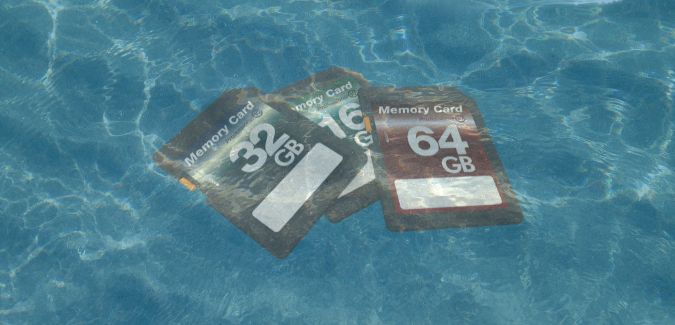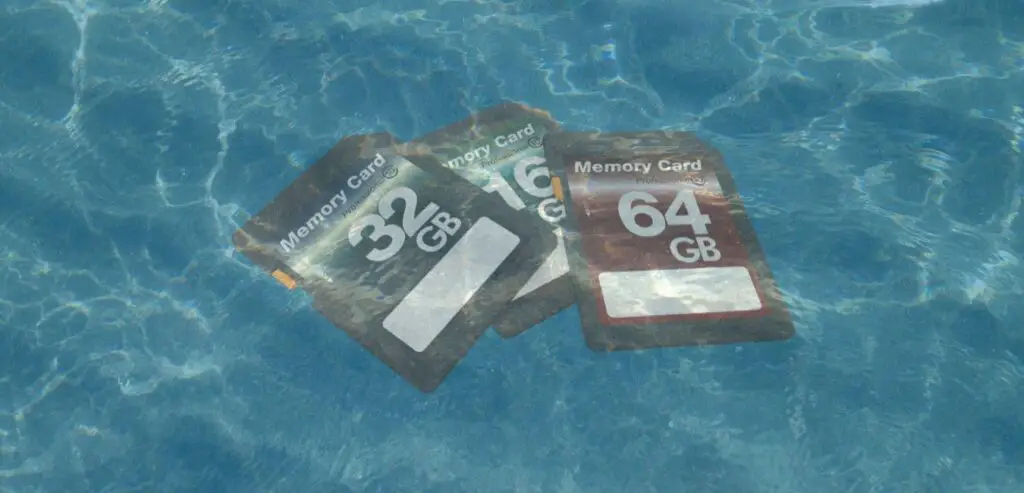SD cards and micro SD memory cards are small, portable, and easy to use. But are they waterproof? Turns out, the answer is a bit more complicated than a simple yes or no. In this article, we’ll explore what you need to know about SD cards and water resistance.
Table of Contents
Are SD Cards and micro SD Cards Waterproof?
No, SD cards and micro SD cards are not waterproof. Despite the wording used by some manufacturers may claim, or what you may have read elsewhere, these memory cards are not immune to the damaging effects of water. Water can cause corrosion and damage to the delicate electronic components inside the card.
Instead of being impervious to water, meaning that water cannot penetrate into or damage them, most SD and micro SD memory cards are water resistant, meaning that they can withstand some exposure to water.
Why Are Memory Cards Referred to as Waterproof When They Are Not?
The reason why memory cards are referred to as waterproof when they are not, probably revolves around the confusion surrounding what the term “waterproof” really means. A lot of people think that if a product still works after they accidentally spill some liquid on it or drop it in water, then it must be waterproof, when in fact it may only be water resistant.
The phrase water-resistant implies that it is something less than waterproof, which it is. However, it is understandable why companies started referring to water-resistant products as waterproof when they realized that many people’s understanding of the term waterproof more closely aligns with the definition of the term water resistant. Then once one manufacturer of a water-resistant product began using the term waterproof to describe the qualities of their product, other companies followed suit so their water-resistant products wouldn’t appear to be inferior.
How Effective Are SD Cards in Protecting Data From Water Damage?
While I don’t want to say 100% of the memory cards sold are water resistant, because I simply haven’t researched every card, I can say that most cards do an amazing job of withstanding water. I’ve had my cards get wet in rain storms, accidentally get water spilled on them, and even had one go through the washing machine. I’ve found that the vast majority of cards are very resilient and just keep working despite any accidental exposure to water.
Most cards that are labeled as being waterproof, and even some cards that aren’t labeled as waterproof, can withstand that accidental spill and not be ruined. Some card manufacturers will even tell you that their cards can even survive being submerged. For example, SanDisk will tell you that their SD, SDHC, microSD, and microSDHC memory cards are tested to withstand up to 72 hours in 1m salt or fresh water.
In general, manufacturers are pretty effective at making SD cards that protect data from accidental water damage, but users should still be careful to avoid exposing their cards to excessive moisture.
How to Ensure That Your Micro SD Card Is Waterproof?
While most cards these days are designed to have some amount of water resistance how do you know which cards do and which cards don’t come with this built-in protection and how can you tell what level of protection they have? You probably aren’t going to see anything on the card itself that will confirm whether or not it is water-resistant. Instead, you should look at the card’s packaging or check on the manufacturer’s website. When trying to verify that an SD card is water resistant there are two things you should be looking for.
1. IP Rating
One way to tell if your micro SD card is waterproof is to check the IP (ingress protection) rating. The IP rating is a measure of how well a device is protected against dust and water.
The rating for a device includes the letters IP, followed by a two-digit number and sometimes a letter. IEC 60529 (an international standard) categorizes the levels of protection a product offers against solids, dust, water, and accidental contact inside electrical enclosures. These norms offer consumers more details than broad, imprecise, or undefined marketing terms like “waterproof”.
How to Read and Understand the IP Ratings
The first number refers to the size of the elements (for example, particulate matter, including dust) that will be prevented from entering the device, while the second number gives us information about the product’s ability to resist water ingress.
If an “X” takes the place of either of those numbers (the initial one, most commonly) it doesn’t mean that it provides no protection from that object. Instead, the only thing we can know for certain is that the producer does not claim a particular ranking for it.
The higher the first or second digit is in the IP rating, the more protection the product offers from particulate matter (first digit) or water (second digit). Below are two charts that explain the exact level of protection the numbers say a product provides from solids and liquids.
First Number in IP Ratings (Solids)
| Level | Object Size Protected Against | Effective Against |
|---|---|---|
| 0 | Not protected | No protection against contact and ingress of objects |
| 1 | >50mm | Any large surface of the body, such as the back of the hand, but no protection against deliberate contact with a body part. |
| 2 | >12.5mm | Fingers or similar objects. |
| 3 | >2.5mm | Tools, thick wires, etc. |
| 4 | >1mm | Most wires, screws, etc. |
| 5 | Dust Protected | Ingress of dust is not entirely prevented, but it must not enter in sufficient quantity to interfere with the satisfactory operation of the equipment; complete protection against contact. |
| 6 | Dust Tight | No ingress of dust; complete protection against contact. |
Second Number in IP Ratings (Liquids)
| Level | Object Size Protected Against | Effective Against |
|---|---|---|
| 0 | Not Protected | - |
| 1 | Dripping Water | Dripping water (vertically falling drops) shall have no harmful effect. |
| 2 | Dripping Water When Tilted Up to 15° | Vertically dripping water shall have no harmful effect when the enclosure is tilted at an angle up to 15° from its normal position. |
| 3 | Spraying Water | Water falling as a spray at any angle up to 60° from the vertical shall have no harmful effect. |
| 4 | Splashing Water | Water splashing against the enclosure from any direction shall have no harmful effect. |
| 5 | Water Jets | Water projected by a nozzle (6.3mm) against enclosure from any direction shall have no harmful effects. |
| 6 | Powerful Water Jets | Water projected in powerful jets (12.5mm nozzle) against the enclosure from any direction shall have no harmful effects. |
| 7 | Immersion up to 1m | Ingress of water in harmful quantity shall not be possible when the enclosure is immersed in water under defined conditions of pressure and time (up to 1 m of submersion). |
| 8 | Immersion beyond 1m | The equipment is suitable for continuous immersion in water under conditions which shall be specified by the manufacturer. Normally, this will mean that the equipment is hermetically sealed. However, with certain types of equipment, it can mean that water can enter but only in such a manner that it produces no harmful effects. |
2. Manufacturer Claims About What the Card Can Withstand
If your card isn’t labeled with an IP rating on the card itself or on the packaging the card came in, and most are not, there are a few ways to look into its water resistance. First, check the packaging for any mention of water resistance. Second, consult the manufacturer’s website where you might find an IP rating or see claims of their cards being able to withstand contact with or being submerged under water.
While seeing the manufacturer’s claims isn’t a guarantee of an IP rating you can use the charts shown above to come up with an approximate rating based on their claims.
Note: Be sure that when you are looking up information about a card on the manufacturer’s website that you are looking up information about the specific card you are looking at. It is common for companies to make different models or lines of cards that have different capabilities in terms of the abuse they can withstand from the elements.
In the end, if you need a memory card that is water resistant and you’re not sure about the card you are considering, err on the side of caution and assume the card is not waterproof and opt for a card that you know offers this protection.
FAQs Related to Whether SD Cards Are Waterproof?
Are Micro SD Cards Waterproof?
Micro SD cards are not waterproof, but similar to SD cards many of them are water resistant. This means that they can withstand being exposed and in some cases submerged in water for a period of time without being damaged.
However, just as with conventional SD cards, it can be tough to determine the water resistance of a micro SD card is unless it has an IP rating printed on the card’s label or packaging. The manufacturer’s website is another great place to look for water resistance information either in the product’s description or in the warranty information section. Additionally, you can contact the manufacturer directly and ask whether or not the micro SD card is water resistant.
What Are the Consequences of Using a Micro SD Card That Is Not Waterproof?
Water damages an SD card by causing the metal contacts to corrode, making it difficult for the card to connect to devices. In addition, the water can damage the delicate circuitry inside the card, corrupting the card and making it unable to store or retrieve data.
How Long Can an SD or Micro SD Card Be Immersed in Water Before It Becomes Unusable?
It is difficult to answer definitively how long an SD or micro SD card can be submerged in water before it becomes damaged. There are a number of factors that come into play, including the specific memory card model, the depth of the water, and the length of time the card is submerged.
As shown in the chart we displayed earlier, companies can make products with different levels of ingress protection against water, which makes the answer to how long SD cards can be immersed in water without being damaged less clear-cut. In addition to the different levels of ingress protection, only the highest levels offer protection from water while being submerged in water. Then for those levels of protection that do allow for submersion in water, the depth of the water determines the IP level, and for each of those levels of protection the exact conditions of the immersion, including the amount of time, are specified by the manufacturer.
All of this means that for some cards the answer to the question of how long they can be immersed in water before they are damaged is, they can’t. For the many cards that are built to be able to withstand being submerged in water, the depth of the water they can be submerged in and the amount of time they can be submerged can vary from card to card or company to company.
Generally speaking, if a card can withstand being submerged in water, most of them can handle being submerged in up to 1 meter of water for up to 30 minutes. If a card is supposed to be able to be submerged in water and you need to know if it can withstand accidental immersion in water that is deeper than 1 meter or for longer than 30 minutes, and this information isn’t on the cards packaging or the manufacturer’s website, you should contact the manufacture directly to get your question answered.
What Are the Best Waterproof SD Cards on the Market?
There are a number of companies that make great waterproof SD and micro SD cards (or more accurately water-resistant cards). Over the years I have had a lot of experience with SanDisk cards, but I have had good luck with Lexar, Sony, Samsung, Micro Center, Kingston, and PNY cards too. There are a number of great options out there, so you should have no trouble finding a card that works well for your needs and your budget.
What Is the Best Way to Store and Protect Your SD and Micro SD Cards?
One of the best ways to store and protect your SD and micro SD cards is to keep them in a water-resistant memory card case. This will help to keep them safe from the elements when you are outside and prevent them from getting wet. These convenient cases come in a variety of sizes and are usually both anti-shock and water-resistant. You can find a variety of these water-resistant memory card cases affordably priced on Amazon.
Another thing that you can do if you want to keep just a few SD or micro SD cards safe from moisture is to put them in a ziplock plastic bag. I will do this if I am going to be outside checking trail cameras on a rainy day, which can be a great time to check trail cameras by the way, and I don’t want to have to worry about my cards getting wet.
What to Do if Your SD or Micro SD Card Gets Wet?
If your SD or micro SD card gets wet, the first thing you should do is dry it off. It was in a device when it got exposed to water, remove the card from the device it was in and dry it off completely wiping off the moisture from the exterior of the card.
As you are drying off the card make sure that its contacts are free from dirt and debris. Sometimes cards that are exposed to liquids won’t work when you try to use them again simply because the metal contacts are dirty and unable to make a connection with the device you put them in. To avoid this, make sure to clean the contacts off when you’re wiping the card down after it’s gotten wet.
Depending on the situation, some memory cards may still not want to work, even after you have wiped the moisture off the exterior and made sure that the contacts are clean. Don’t give up if that happens to you. Instead, let the card sit and have an extended period of time to dry, and sometimes these cards will begin working again. Some people who are in this situation will try putting their card in a bag of rice in hopes that the rice will act as a desiccant and help to dry the card out. I haven’t ever tried putting an SD card that was water damaged into a bag of rice so I can neither confirm nor deny whether or not this actually does work but many people claim they had success with doing this method before giving up hope all together on a non-functioning memory card that was exposed to water.
Do I Really Need a Memory Card That Is Water Resistant?
The answer to this question will vary from person to person since it really depends on what you plan to use your SD card for.
If you know for sure that you will be using your device in a wet or outdoor environment, then it might be worth it to get a water-resistant memory card. Even if you plan on using the card in a device that was designed for outdoor use, these devices usually have their own IP rating and rubber seals that make them resistant to water. This means that the device itself protects the memory card from water damage. So unless the card might be exposed to water when you are putting it into and taking it out of the device you are probably just fine using a card that doesn’t have water resistance built in.
However, if you’re only going to be using your device indoors or in dry conditions, then a regular SD card should suffice unless you expect the card will be at high risk of being exposed to accidental spills.
Ultimately, whether or not you should use a water-resistant memory card comes down to personal preference and knowing where and what you’ll be using your device for. However, if you are not sure what device you will be using the card in or whether or not it will be exposed to water, it is always better to be safe and use a water-resistant card.
Final Thoughts
Despite the wording used by some manufacturers, or what you may have read elsewhere, SD and micro SD memory cards are not completely immune to the damaging effects of water. While most people don’t think twice about whether their memory card is waterproof or not, it is important to know whether your memory card is up to the task if you are planning on using it in inclement weather or around water.
While manufacturers don’t all communicate whether or not their cards can withstand contact with water in the same way, you can find out if a card is water-resistant by looking for the card’s IP rating or descriptions of water resistance capabilities on its packaging or on the company website. Thankfully, these days there are a large number of water-resistant memory cards making it easy to find one that meets your performance needs and budget.
Last update on 2024-04-26 at 15:55 / Affiliate links / Images from Amazon Product Advertising API







